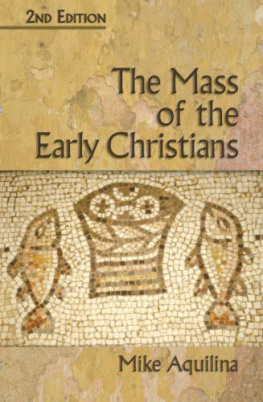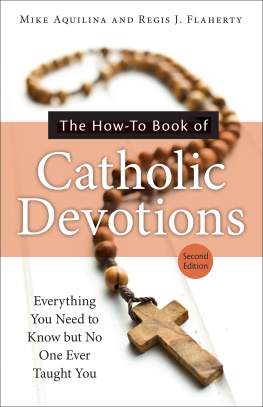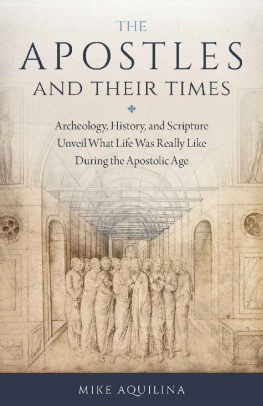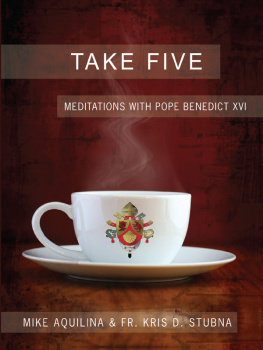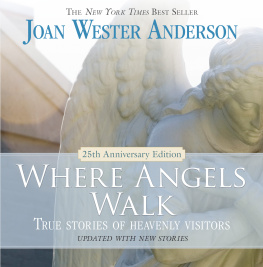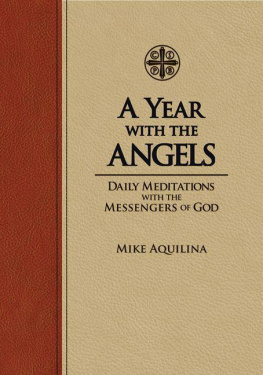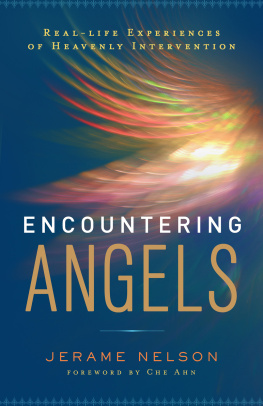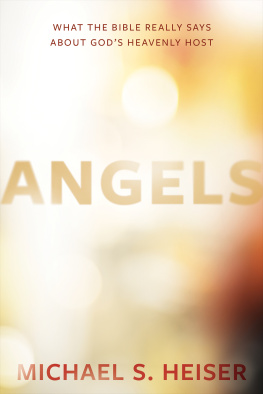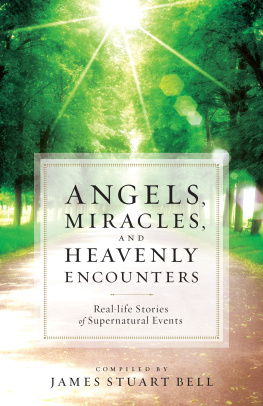Table of Contents
Excerpts from The Fathers of the Church: Expanded Edition, by Mike Aquilina, copyright 2006 by Our Sunday Visitor, are used by permission of Our Sunday Visitor.
Unless otherwise noted, Scripture passages have been taken from the Revised Standard Version , Catholic edition. Copyright 1946, 1952, 1971 by the Division of Christian Education of the National Council of Churches of Christ in the USA. Used by permission. All rights reserved.
Note: The editors of this volume have made minor changes in capitalization to some of the Scripture quotations herein. Please consult the original source for proper capitalization.
Cover and book design by Mark Sullivan
Cover image: Angelico, Fra (1387-1455). Detail of Angel Annunciate from the Polyptych of the Dominicans. Galleria Nazionale dellUmbria, Perugia, Italy.
Photo credit: Scala/Art Resource, NY
Library of Congress Cataloging-in-Publication Data
Aquilina, Mike.
Angels of God : the Bible, the church, and the heavenly hosts / Mike Aquilina.
p. cm.
Includes bibliographical references.
ISBN 978-0-86716-898-3 (pbk. : alk. paper) 1. Angels. I. Title.
BT966.3.A68 2009
235.3 dc22
2008056005
PRINT ISBN 978-0-86716-898-3
E-BOOK ISBN 978-1-61636-215-7
Copyright 2009, Mike Aquilina. All rights reserved.
Published by Servant Books,
an imprint of Franciscan Media
28 W. Liberty St.
Cincinnati, OH 45202
www. AmericanCatholic.org
For Grace Marie
Acknowledgments
Never before have I called upon heaven so much in the preparation of a book, so I would be remiss if I failed to acknowledge the assistance of the angels. If there are errors in the book, I take the blame for not listening well enough.
Im also deeply indebted to several of the sainted ancients, especially Pope Saint Gregory the Great and the author best known as Saint Denis or Dionysius the Areopagite. Their classic angelologies are mind-blowing. Several of their works are available only in nineteenth-century translations that are difficult for modern Americans to read with understanding. (The English language has undergone great changes in two hundred years.) So I have adapted the material, translating it from Victorian English to modern English, consulting the Greek or Latin originals whenever possible.
The main series of translations from which Ive drawn are the Ante-Nicene Fathers and the Nicene and Post-Nicene Fathers , series one and two. All three series are available many places online: Youll find them at www.ccel.org with page numbers intact and at www.NewAdvent.org in plain text. A multivolume reprint edition is available from Hendrickson Publishers in Peabody, Massachusetts.
Im grateful to my colleagues, especially to Chris Bailey who is a dear friend, sometime coauthor, candid critic, brilliant translator and the best editor I know but also to Scott Hahn, David Scott and Rob Corzine, who encouraged me mightily and helped me, as always, to find the most perfect sources in the most hidden corners of the worlds libraries. My two favorite hagiologists, Maureen OBrien and Matthew Bunson, answered some key questions and patiently guided me to ancient and medieval source texts.
My editor, Cindy Cavnar, thought up this book in the first place and insisted that I write it. She is an actual grace in my life.
The poet Coventry Patmore often wrote about his wife; and when he did he portrayed her as an image of the angels:
And, when we knelt, she seemd to beAn angel teaching me to pray.
If I were a poet, I would write something like that for my wife, Terri, who inspires whatever good I do.
Introduction: The Everywhere of Angels
Angels are everywhere!
So proclaims the sweatshirt of the lady who gives me Communion when I go to Mass at a parish near my home. The shirt is oversized, sky blue, with a flock of Victorian angels flitting about the ornate, glittery lettering of the message.
There was a time in my life when I would have found every detail of that shirt annoying from the depiction of the angels, who look a lot like the sugarplum fairies in my kids storybooks, to the exclamation point at the end of the slogan, which violates my every sense of journalistic and theological decorum. But now, for me, that shirt is a prayer. And this book is, in a sense, an amen , my confession of faith.
How did I get from there to here? Its a difficult story to tell, and Ill come to it in a minute.
Our first order of business, though, should be that slogan: Angels are everywhere!
Indeed they are. And Im not talking just about their commercial exploitation. Yes, weve survived the decades when pop culture felt it necessary to remind us that angels were not only in America but also in the architecture and even in the outfield. One author claimed that 10 percent of all popular songs of the 1950s1980s mentioned angels. I havent checked the Billboard charts myself, but I find no reason to doubt his point. In my childhood home the radio was always on, and I thank God I had catechism classes to offset the strange theological suggestions of titles like Earth Angel, Teen Angel, Angel Baby and Undercover Angel, not to mention the dubious metaphysics of Heaven Must Be Missing an Angel.
Angels are everywhere in film and music, and that alone can be a turnoff. Hollywood tends to trivialize angels the way it trivializes sex, reducing something profoundly spiritual to a mere curiosity before mass-producing it into an inescapable nuisance irritating as an unforgettable advertising jingle. Our temptation is to lose interest in the subject entirely, to dismiss the study of angels as a pastime of flakey New Age types or very sweet coworkers who also collect unicorns and rainbow sun catchers. Its then that we wince at the sight of an Angels are everywhere! sweatshirt.
But we mustnt allow Hollywood and Madison Avenue to win in this way. I say this not because angels are sensitive beings who will be hurt by our ingratitude but because angels are a large part of reality and, as with other large parts of reality speeding Mack trucks, for example, or looming brick walls we benefit greatly from their service, and we ignore them at our peril.
The truth is that angels are everywhere, and Id like us to spend this book pondering the many ways that statement is true. First, though, lets consider some that should be obvious to us but perhaps are not.
Angels are everywhere in Scripture . We find angels from the first pages of Genesis to the last pages of Revelation, and not just as bit players. They play crucial roles in the drama of our creation, fall and salvation.
In the beginning it is a fallen angel, in the form of a serpent, who tempts Adam and Eve. When our first parents are expelled from the Garden, God places angels at the entryway as a sign of judgment. It is an angel who stays the hand of Abraham when he is about to sacrifice Isaac. Angels watch over Moses and the Israelites as they make their exodus from Egypt and as they receive the law from God. Angels minister at the temple of Solomon. Angels deliver the word of the Lord to the prophets.
The trend continues through the New Testament. Angels announce the conception and birth of Jesus and of John the Baptist. Angels guide all sorts of people to worship at the crib of Jesus. Angels guide the Holy Family away from imminent danger. Angels minister to Jesus when hes fasting in the desert and when hes suffering in the garden. Angels watch at his empty tomb and accompany him at his ascension, announcing his glory as at his birth. Angels accompany the apostles as they establish the Church of Christ. The book of Revelation and the Letter to the Hebrews show us that angels are continually at work in our Church and in our world.
Angels are everywhere in our prayer . In the Mass two of the most beloved prayers are songs that, according to Scripture, mankind learned from the angels: the Gloria (Luke 2:1314: Glory to God in the highest!) and the Sanctus (Isaiah 6:23: Holy, holy, holy!). The Church often invokes the heavenly host at the Preface of the Eucharistic Prayer: And so, with all the choirs of angels in heaven / we proclaim your glory / and join in their unending hymn of praise. angelic prayer is hardly something we reserve for Sunday Mass. Catholics imitate and invoke the angels in many of the devotions that have been popular through the centuries. When we pray the Hail Mary, we are praying the words that the angel spoke to the Blessed Virgin, as they are recorded in Saint Lukes Gospel (see Luke 1:28). When we offer the traditional noontime prayer, the Angelus , we recall that very story of the Annunciation to Mary. For more than a century now, the popes have encouraged recitation of certain prayers to Saint Michael the Archangel.
Next page

